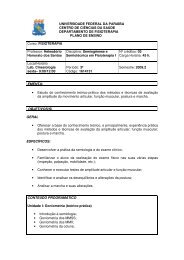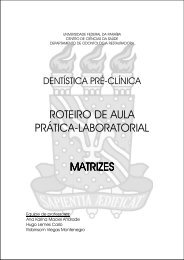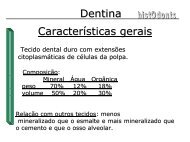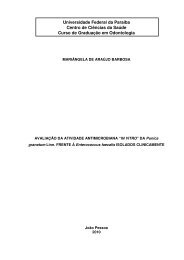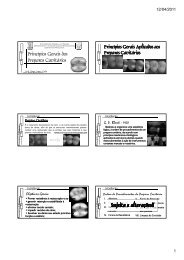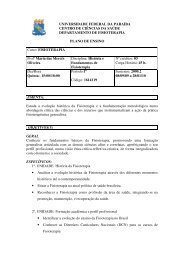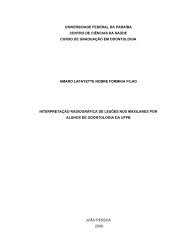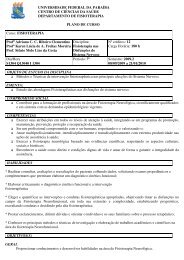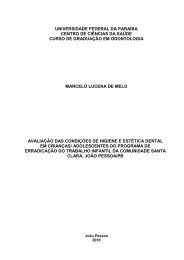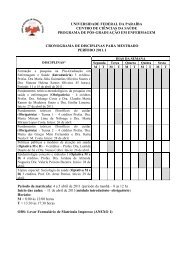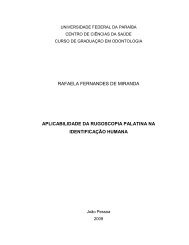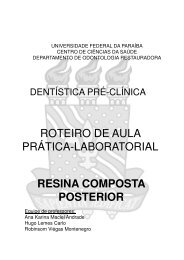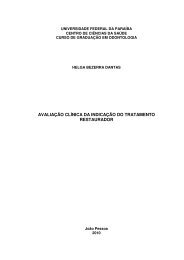An assessment of rubber dam usage amongst specialists in ... - CCS
An assessment of rubber dam usage amongst specialists in ... - CCS
An assessment of rubber dam usage amongst specialists in ... - CCS
You also want an ePaper? Increase the reach of your titles
YUMPU automatically turns print PDFs into web optimized ePapers that Google loves.
Rubber <strong>dam</strong> <strong>usage</strong> <strong>amongst</strong> <strong>specialists</strong> 53<br />
Table 1. Samples <strong>of</strong> respondents’ comments.<br />
Not <strong>in</strong> favour <strong>of</strong> <strong>rubber</strong> <strong>dam</strong><br />
‘I treat most <strong>of</strong> my patients with <strong>in</strong>halation sedation … Improved<br />
cooperation makes it easier to achieve excellent isolation for teeth’<br />
‘Poor patient compliance <strong>in</strong> primary care sett<strong>in</strong>g − I have always<br />
found patients (or parents) accept it better <strong>in</strong> a dental hospital<br />
environment, rather than <strong>in</strong> a community cl<strong>in</strong>ic’<br />
‘I see my sealants, which have been place <strong>in</strong> some <strong>in</strong>stances<br />
10 years ago, and therefore, do not believe <strong>rubber</strong> <strong>dam</strong> would<br />
add any extra benefits … This does take a lot <strong>of</strong> experience/<br />
expertise though’<br />
In favour <strong>of</strong> <strong>rubber</strong> <strong>dam</strong><br />
‘Can potentiate effect <strong>of</strong> relative analgesia, which can be helpful<br />
if care taken not to over-sedate’<br />
‘Rubber <strong>dam</strong> is an <strong>in</strong>valuable adjunct to paediatric dentistry. The<br />
reason most dentists can’t use it is because they were taught by<br />
dentists who can’t (and don’t) use it’<br />
‘Quality care for children cannot be achieved without it’<br />
Other comments regard<strong>in</strong>g <strong>rubber</strong> <strong>dam</strong><br />
‘I use <strong>rubber</strong> <strong>dam</strong> fairly <strong>of</strong>ten − I notice parents’/patients’ surprise.<br />
Patient awareness and expectation is a factor and parents are<br />
surprised/shocked that it has not been used for them! Therefore,<br />
better education and overall better standards are needed’<br />
‘Must be regularly taught at all levels, teachers must be seen to<br />
use it at all times’<br />
‘Locally, more equipment, better tra<strong>in</strong>ed nurses to properly assist<br />
its placement’<br />
Discussion<br />
Previous studies have reported various rates <strong>of</strong><br />
RD <strong>usage</strong> 13–16 , and <strong>in</strong> general, these have demonstrated<br />
that there is under-<strong>usage</strong> compared to<br />
current recommendations, a similar f<strong>in</strong>d<strong>in</strong>g to<br />
this study. For example, one survey revealed<br />
that <strong>rubber</strong> <strong>dam</strong> was used <strong>in</strong> 17–19% <strong>of</strong> cases<br />
for restorative treatment, whilst this <strong>in</strong>creased to<br />
62% for endodontic treatment 13 . Furthermore,<br />
it is <strong>in</strong>terest<strong>in</strong>g to note that those work<strong>in</strong>g<br />
with<strong>in</strong> the US Air Force Dental Services used<br />
<strong>rubber</strong> <strong>dam</strong> <strong>in</strong> more cases than their general<br />
and specialist colleagues 14 . In 1990, other<br />
authors work<strong>in</strong>g with<strong>in</strong> the UK reported that<br />
1.4% and 10.9% <strong>of</strong> operative and endodontic<br />
procedures were carried out under RD,<br />
respectively 15 , with the British Endodontic<br />
Society report<strong>in</strong>g that dentists <strong>in</strong> private practice<br />
used <strong>rubber</strong> <strong>dam</strong> more than those <strong>in</strong> NHS<br />
practice 16 . More specifically, <strong>in</strong> relation to paediatric<br />
patients treated with<strong>in</strong> general dental<br />
practice <strong>in</strong> the UK, there would appear to have<br />
been an <strong>in</strong>crease <strong>in</strong> <strong>rubber</strong> <strong>dam</strong> use from 0%<br />
to 9% between 1986 and 1996 17 . It may be<br />
speculated that it is unlikely that the same<br />
f<strong>in</strong>ancial and time constra<strong>in</strong>ts are evident both<br />
with<strong>in</strong> the US forces dental practices and<br />
private practice compared to dentists work<strong>in</strong>g<br />
with<strong>in</strong> general practice. This could perhaps<br />
expla<strong>in</strong> the differences <strong>in</strong> reported <strong>usage</strong> <strong>in</strong><br />
both the above studies and this one between<br />
those <strong>in</strong> salaried posts and private practice<br />
compared with those <strong>in</strong> NHS general practice.<br />
Nonetheless, it would seem that, with<strong>in</strong> various<br />
countries, specialities and methods <strong>of</strong> fund<strong>in</strong>g,<br />
<strong>rubber</strong> <strong>dam</strong> <strong>usage</strong> is not conform<strong>in</strong>g to current<br />
guidel<strong>in</strong>es and recommendations.<br />
The BSPD guidel<strong>in</strong>es recommend <strong>rubber</strong> <strong>dam</strong><br />
isolation ‘wherever possible’ for many procedures<br />
3–6 . Previous workers concluded that<br />
62.6% <strong>of</strong> paediatric dentistry <strong>specialists</strong> reported<br />
‘rout<strong>in</strong>ely’ us<strong>in</strong>g <strong>rubber</strong> <strong>dam</strong> for vital pulpotomies<br />
18 . These authors suggested, however, that<br />
the use <strong>of</strong> the word ‘rout<strong>in</strong>ely’ may have produced<br />
a negative number <strong>of</strong> responses. The results<br />
<strong>of</strong> this study, where respondents were asked how<br />
<strong>of</strong>ten RD was used for primary tooth endodontics,<br />
would suggest a lower figure than this<br />
(they ‘regularly’, ‘almost always’ and ‘always’ use<br />
RD reported <strong>in</strong> 51% <strong>of</strong> non-sedation patients).<br />
In relation to the mode <strong>of</strong> treatment, it was<br />
<strong>in</strong>terest<strong>in</strong>g to note that there was no significant<br />
difference <strong>in</strong> RD <strong>usage</strong> with no sedation,<br />
IHS or DGA. It would seem reasonable to<br />
hypothesize that patient compliance would be<br />
improved and complete patient compliance<br />
would be achieved with IHS and DGA, respectively,<br />
<strong>in</strong> particular. Furthermore, if patient<br />
compliance was no longer an issue and with<br />
this be<strong>in</strong>g the commonest reason cited by<br />
respondents for prevent<strong>in</strong>g use <strong>of</strong> RD, it would<br />
aga<strong>in</strong> seem logical to conclude that RD would<br />
be used more <strong>of</strong>ten <strong>in</strong> such circumstances. This<br />
was not the case, however, although the reasons<br />
for this are unclear. In addition, the authors<br />
note that there was an apparent reduction <strong>in</strong><br />
RD use for permanent tooth endodontics when<br />
carried out under DGA; aga<strong>in</strong>, the reasons for<br />
this are unclear. One possibility is that the<br />
operator assumes that the airway is protected<br />
from <strong>in</strong>halation <strong>of</strong> <strong>in</strong>struments by a throat<br />
pack/laryngeal mask, and hence, that <strong>rubber</strong><br />
<strong>dam</strong> is not required. If the ‘gold standard’ irrigant<br />
solution <strong>of</strong> sodium hypochlorite, however, is<br />
used for irrigation, the authors would argue<br />
that RD would aga<strong>in</strong> be the gold standard to<br />
protect the s<strong>of</strong>t tissues from potential chemical<br />
<strong>dam</strong>age. In relation to IHS and staff safety, RD<br />
© 2006 The Authors<br />
Journal compilation © 2006 BSPD, IAPD and Blackwell Publish<strong>in</strong>g Ltd



